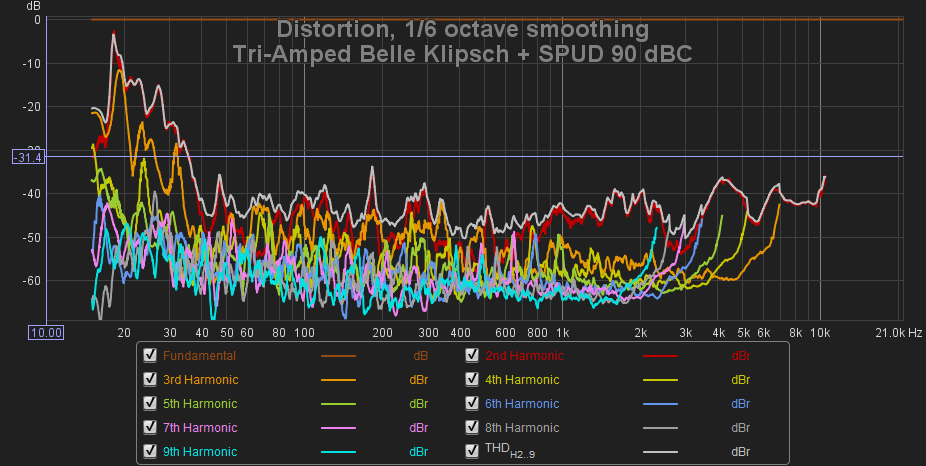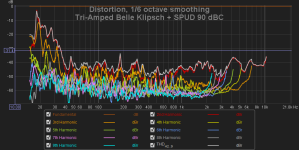Do you see the except when the electronics are near clipping level? Takes a lot of tricky filtering and good detectors or converters to see them in amps at normal operating levels.
Can't swear to the level, but somewhere I've posted some typical FFT plots of this. It was in the DCX2496, so line level, not power amp.
I'm with Bill on this one.
I assume that you're talking about the paper that Nelson Pass did on moderate levels of global feedback in amplifiers. Even then, you're still talking typically 20 and 30 dB higher levels of loudspeaker harmonic distortion at the 7th harmonic level--typically at -50 dB or even high levels for directly radiating drivers for measurements at the 90-100 dB/one metre level. (The HD levels in amplifiers I still find to be audible--because those HD products turn into modulation distortion sidebands at higher frequencies, and are especially audible on musical transients.)
Pano/planet10: what measurement systems and overall SPL are you using to form your opinions?
But do speaker drivers do the clusters of high harmonics like we see in active electronics?
I assume that you're talking about the paper that Nelson Pass did on moderate levels of global feedback in amplifiers. Even then, you're still talking typically 20 and 30 dB higher levels of loudspeaker harmonic distortion at the 7th harmonic level--typically at -50 dB or even high levels for directly radiating drivers for measurements at the 90-100 dB/one metre level. (The HD levels in amplifiers I still find to be audible--because those HD products turn into modulation distortion sidebands at higher frequencies, and are especially audible on musical transients.)
Pano/planet10: what measurement systems and overall SPL are you using to form your opinions?
So you're not going to answer the question because of the word used?
Okay: let's substitute the word "observations" for "opinions".
There was a reason for using the original word, but I'll play along...
Chris
Okay: let's substitute the word "observations" for "opinions".
There was a reason for using the original word, but I'll play along...
Chris
Last edited:
The use of the word "opinion" is typically used to discredit the claim, which is not an unreasonable thing to do, if the claim is no more than opinion. That's why I asked for clarification.
But they are just measurements, and I was only curious if anyone had seen clusters of high harmonics from a speaker, as you might find in active circuits. I have not, but admit I haven't been looking! 🙂
Setting up a test rig and a few drivers (I no longer have many) would be interesting, as I've never paid much attention to high harmonics in speakers.
But they are just measurements, and I was only curious if anyone had seen clusters of high harmonics from a speaker, as you might find in active circuits. I have not, but admit I haven't been looking! 🙂
Setting up a test rig and a few drivers (I no longer have many) would be interesting, as I've never paid much attention to high harmonics in speakers.
what measurement systems and overall SPL
I’m with Geddes who had a conversion after doing scientific studies that the distortion measurements we do aren’t worth the pixels they ar eprinted with.
I do admit that i typically don’t listen really loud, certainly not enuff to worry about hearing loss.
dave
I haven't seen them in non-experimental amplifiers except when the level is high except at like 80dB down (which is pretty dang hard for a speaker test given typical room noise levels)
I would be interested too, but, considering a speaker is a passive device I can't imagine any mechanism that would mean they wouldn't just keep decreasing. As I understand it, much of the higher harmonic content in amplifiers is due to feedback?I was only curious if anyone had seen clusters of high harmonics from a speaker, as you might find in active circuits.
Well I don't remember ever seeing high harmonics in drivers. But maybe they were just buried in the noise, or I wasn't looking for them.
I’m with Geddes who had a conversion after doing scientific studies that the distortion measurements we do aren’t worth the pixels they ar eprinted with.
I do admit that i typically don’t listen really loud...
IIRC, Geddes stopped his experiments at 80 dBA--due to OSHA restrictions.
A tri-amped Belle Klipsch with TH-SPUD subs at 90 dBA/1m, showing harmonics 2-9...normalized to fundamental...is shown below.

Loudspeaker harmonic distortion is a pretty strong function of output SPL...and if you don't listen to them at anywhere near concert level, then you'd probably have the opinion that they don't produce higher than 3rd harmonic distortion. They do, however.
A Belle in this configuration (tri-amped) is a pretty clean reproducer at 90 dBA/1m. In fact it's still clean at 105 dBA/1m, although that's typically louder than I listen, except perhaps during big uncompressed music or sound effect transients while in the 5.1 (movie) mode, etc. The input power required to drive one at the 105 dB level: about one watt RMS.
Loudspeaker harmonic distortion is a pretty strong function of output SPL...and if you don't listen to them at anywhere near concert level, then you'd probably have the opinion that they don't produce higher than 3rd harmonic distortion. They do, however.
A Belle in this configuration (tri-amped) is a pretty clean reproducer at 90 dBA/1m. In fact it's still clean at 105 dBA/1m, although that's typically louder than I listen, except perhaps during big uncompressed music or sound effect transients while in the 5.1 (movie) mode, etc. The input power required to drive one at the 105 dB level: about one watt RMS.
Attachments
Thanks Cask, just what I was looking for! I'll study it a bit.
FYI, here is the sort electronic distortion I was talking about. Here shown at line level, but I've seen it in power amps, too.
Behringer DCX2496 digital X-over
Getting back in topic -
FYI, here is the sort electronic distortion I was talking about. Here shown at line level, but I've seen it in power amps, too.
Behringer DCX2496 digital X-over
Getting back in topic -
Yes, to what extent? And how do you measure that? Compare the distortion of a 2 or 3 ways system to a fullrange?For what i understand, multi-way will help in that regards by dividing the tasks among drivers that are in their comfort zones. But to what extent?
I tend to wonder how much of those upper (higher-order) harmonics are elevated due to the noise floor of the overall measurement..
I also wonder about the sweep itself (..its freq. extension) when I see very ordered "up-lifting" upper harmonics higher in freq.. (..which is stuff I personally disregard.) 😉
I tend to wonder how much of those upper (higher-order) harmonics are elevated due to the noise floor of the overall measurement.
Or distortion in the driving amplifier?
dave
- Status
- Not open for further replies.
- Home
- Loudspeakers
- Multi-Way
- Does multi-way reduce *audible* Harmonic Distortion ?
